I discovered Dry Eye Talk forums when I was researching scleral lenses as a result of conversations at the ANA Eye Issues Forum. It’s part of the very helpful site Dry Eye Zone, which also hosts news items pertaining to dry eye, an encyclopedia of dry eye topics, a computer blink reminder, and a Dry Eye Shop.
I never knew there were so many causes of dry eye, or that LASIK was one of them. As a extremely nearsighted, middle-aged woman with large pupils, I am fortunate to be a LASIK success story. However, thanks to post-surgical facial paresis, I became all too familiar with the pain and misery of dry eye. Early on I got a platinum eyelid implant. It aided nighttime closure but still left an incomplete blink.
One of the forum categories at Dry Eye Talk is Our Dry Eye Triumphs. After more than five years, I feel that I have finally arrived at that point. The remainder of this post is a before and after comparison of my dry eye care routine.
Before
I tried every type of eye drop, gel and ointment I could find. Eye drops and gels, no matter how thick, gave only a fleeting moment of relief. Standard eye ointments containing about 15% mineral oil and 85% white petrolatum offered 15-20 minutes of relief before I needed to reapply. Refresh PM, with a higher proportion of mineral oil (42.5%), gave me much longer relief. I always applied it before bedtime and first thing in the morning. During the summer that might be all I needed; during the winter I usually required a mid-afternoon application as well. Although some less expensive store brands, such as Walmart and Walgreens, contain the same proportion of ingredients, they did not work as well for me.
My eyes felt pretty good, but the vision on the left side was blurry, like looking through a lens smeared with vaseline. My brain learned to compensate, relying more on the clear vision in my right eye while utilizing the images from the left eye for depth perception. My overall vision was similar to this image, courtesy of Visionsimulations.com:
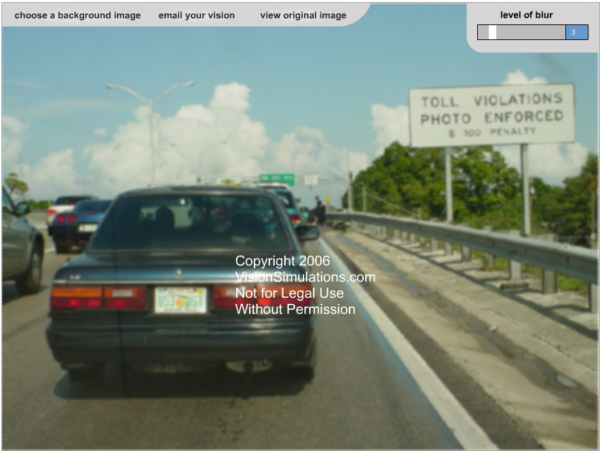
My method of applying ointment was a bit unconventional. Instead of squeezing it onto my eye from the tube, I put a small amount on my ring finger and applied it to the sclera below the iris, then closed my eye to distribute it over the cornea. I’m sure ointment manufacturers and eye care professionals alike would be appalled, but it worked for me. For nearly five years, 24/7 application of Refresh PM ointment comprised my eye care routine.
For a while, the absence of dry eye pain compensated for the loss of crystal clear vision. But over time I began to experience mental fatigue from the continuous effort of concentrating on my right-side vision. That, with the nearly constant nuisance of extra ointment under my eye – which also made wearing eye makeup an impossibility – led me to begin researching scleral lenses in earnest.
After
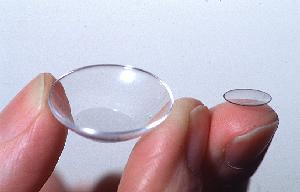
A scleral lens is much larger than a standard gas permeable contact and vaults the cornea, allowing a pool of saline to remain between the lens and the surface of the eye to combat dryness. Scleral lenses are more expensive because they require a precision fitting process. In my case, the first lens turned out to be too loose, but the second one is just right.
Here is the rest of my new eye care routine. Yes, it costs more and takes more time.
Solutions:
- Scleral lenses must be filled with preservative-free saline prior to insertion. Large bottles of saline contain preservatives, which leaves the more expensive option of individual vials. There are many brands with varying levels of lubricating agents added. Individual vials contain 2-3ml of fluid, which is just enough to fill a scleral lens. I found a much more cost-effective option to be sterile saline vials manufactured for nebulizer use. They are available in 3ml, 5ml and 15ml sizes. They contain no lubricating ingredients, and the lid can’t be snapped back on once opened. I prefer the 5ml size because it contains enough to both rinse and fill the lens. Beginners often need more than one attempt at insertion, so there is extra to allow for that. Any extra saline can either be discarded or used at the end of the day to rinse the lens after removal, but should not be kept for use the next day. I’m fairly sure 5ml would still be sufficient for two scleral lenses. Amazon.com has the lowest prices I’ve found for nebulizer saline. I usually buy 100 vials for around $15, but they are also available in quantities of 1000 for about $125.
- At the end of the day when I remove my lens. I use a daily cleaner called Lobob ESC to remove surface dirt and oils.
- I prefer UniquePH multipurpose solution for soaking and disinfecting. It is not available locally (at least here) and is sometimes hard to find online, in which case I use Lobob CDS but I don’t like it as well.
Tools:
- DMV Lens Insertion Tool – there is a great YouTube video that shows techniques for manual insertion and removal of scleral lenses, but I don’t like the thought of it, plus there is the possibility of getting skin oil or soap/lotion residue on the lens. I prefer to use an insertion tool, like the one pictured at left.
- DMV Removal Tool – the thought of breaking the suction between the lens and my eye using my fingers just gives me the creeps. I very very very very much prefer to use a removal plunger, pictured at right. There is also a plain suction cup without a hollow, but I prefer the way this one allows suction to be started and stopped by squeezing the bulb.
- Mirror – I place a hand mirror on the bathroom counter during lens insertion. The insertion tool is hollow all the way through, so I line up the reflection. When I can see the excess fluid spilling out, I know the lens is in the right place. I use the regular bathroom mirror during removal to find the right spot to apply the suction cup.
Tips:
- During insertion, tuck your chin toward your chest until your eye has to look slightly up toward the mirror. That keeps the lens level and the fluid in the cup through the insertion process.
- Blink hard a few times after insertion to help center the lens. You will notice your vision getting appreciably clearer with each blink.
- If you see ghosted images after insertion, too much fluid was displaced and there is an air bubble in the lens. Take it out right away to refill and reinsert, because in just a few seconds it will begin to smart like crazy.
- During removal, apply the suction cup to the outer edge of the lens. If the suction cup is in the middle of the lens, it will increase rather than break the suction. Placing a drop of saline on both the contact and the removal tool helps a lot. If the suction is still hard to break, try gently moving the edge of the lens slightly back and forth with the suction cup before trying again.
- If your vision starts to blur during the day, apply a drop of saline over the lens and blink a couple of times. If this doesn’t help, remove the lens, refill with fresh sterile and reinsert. Blink hard a few times to recenter the lens.
 Nighttime care: At first, I continued using Refresh PM whenever I was not wearing the scleral lens. My optometrist recommended using lubricating eye drops with a silicon eye shield at night, but I needed the security of my old method for a few weeks. I was extremely happy once I made the switch. The lens stays cleaner and my eyes feel even better in the morning. Often I can wait two or three hours before having to put in my scleral.
Nighttime care: At first, I continued using Refresh PM whenever I was not wearing the scleral lens. My optometrist recommended using lubricating eye drops with a silicon eye shield at night, but I needed the security of my old method for a few weeks. I was extremely happy once I made the switch. The lens stays cleaner and my eyes feel even better in the morning. Often I can wait two or three hours before having to put in my scleral.
- TheraTears Liquid Gel drops – I’ve tried a lot of different lubricating eye drops and this one is my favorite. It’s a thick solution and my eyes feel better in the morning than with any other drop I have tried. The top of these vials can be snapped shut, and although it is not recommended, I generally use a vial for two nights. Bonus: there is a $2 coupon good through 2013 available here and a $1 coupon good through 2014 available here.
- Quartz silicon eye shield – also available in a dark version called Onyix. It was originally developed to combat dry eye among CPAP users, and is made by the same manufacturer as another nighttime dry eye product, TranquilEyes. I have found a couple of drawbacks with the Quartz shield. First, it tends to leave marks on my cheeks that take up to an hour to fade. Also, the adjustable fabric band tends to slip so I use hair clips or bobby pins to keep it in place. Fortunately, that way it does not have to be as tight so the morning marks aren’t quite so bad. TranquilEyes are supposedly less likely to leave marks, but they are not available in a clear version so I will probably stick with the Quartz shield.
The vision in my right eye has slightly diminished to -1.0 since my LASIK surgery thirteen years ago. I am not currently wearing a contact on that eye. I wear a pair of prescription glasses with clip-on sunglasses to drive and sometimes at the movie theater or to watch TV. Since I ended up with classic monovision, I rarely need to wear readers to read or work on the computer. I will decide by my next scleral appointment, currently scheduled for July 2014, whether I want another lens for the right side or if I am content to continue this way.
I keep a a few necessities in my purse in case of emergency – a spare set of insertion and removal tools, contact case, saline and Thera Tears Gel vials, alcohol wipes, a compact mirror and a tube of Refresh PM. My new eye routine definitely requires more money, time and stuff. But is it worth it? Well, the optometrist tells me that my eye is healthier. I am less fatigued at the end of the day. I no longer have to worry about wiping extra eye ointment off my cheek. I can wear eye makeup when I choose to. And best of all, I now see like this:
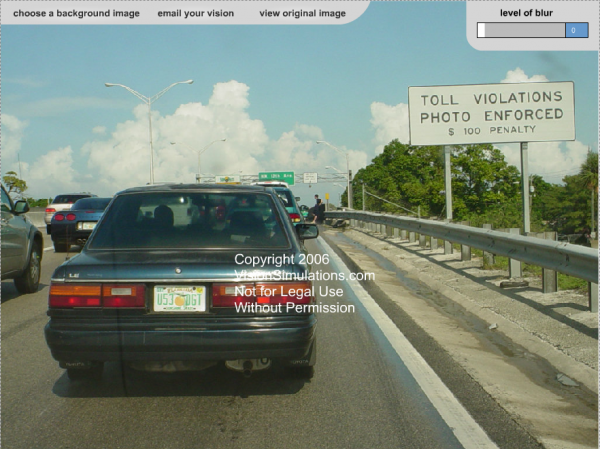
I am still waiting for the outcome of an appeal to my insurance company to cover the scleral lens as a prosthetic device for a nonfunctional eyelid. My argument is that it will decrease the possibility of corneal disease and accident. Whatever their decision, there is no question that the lens enhances my quality of life.
Read my next post on scleral lenses.
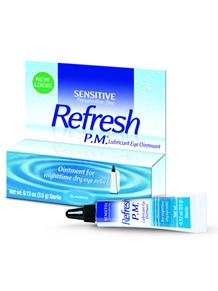

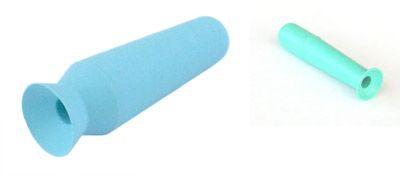

Sara, that is really a process–or 2 processes, actually. Glad you found one that works for you and gives you both vision & relief. I hope this post will help other dry-eye sufferers.
Sara, thank you so much for your wonderfully written account. I have been suffering with dry eye for 9 years due to my acoustic neuroma surgery. Like you, I have tried countless drops and lubricant gels. The only thing that keeps me going is Refresh PM. On a good day, I only use it a few times, but many days I have to apply it as many as 6-7 times. I constantly have a pool of it under my eye and my upper lid gets coated, as well. I gave up wearing make up long ago. I’ve recently begun seeing a new eye doctor, and after reading your story, I plan to ask about the scleral lens. Thank you for giving me hope.
to Lynn McCoy, how was it determined that your dry eyes was caused by the acoustic neuroma surgery? I had the ANS 4 yrs ago & now have dry eyes.
very depressed no one believes me that it was caused by the ANS
Diane
Thank you Sara for your wonderful post! I will use Teratears liquid gel and Quartz silicone shield, will see how that goes.
Thank you for the story of your dry eye journey and all the very helpful pointers and tips. I have cornea degeneration and chronic dry eye that drops and plugs have not helped. I am scheduled to get Sclera lenses this month. Wow, SO expensive and insane to not be covered by insurance. I was certainly use your helpful tips!